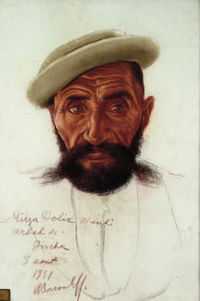Wakhi people
 Portrait of a Wakhi man | |
| Total population | |
|---|---|
| Est. 70,000-100,000 | |
| Regions with significant populations | |
| Afghanistan, Tajikistan, Pakistan, China, Russia | |
| Languages | |
| Wakhi | |
| Religion | |
| Ismaili Islam, Ethnic religion |
The Wakhi people, or Khik (called Guhjali in upper Hunza), are an ethnic group originating in the Wakhan of today's Afghanistan. They also live in adjacent areas of Tajikistan and Xinjiang and in Pakistan (in Chitral District and Gojal) and also live in Russia Moscow.[1][2] They speak the Wakhi language.
Population and demographics
A very rough estimate puts the population of Wakhis between 70,000-100,000.[3][4] The population is divided among four different countries: Afghanistan, Tajikistan, Pakistan, and Xinjiang in north-western China. In China the Wakhi are officially recognized as "Tajiks", in Afghanistan they are officially called "Pamiris", while in Tajikistan Wakhi are recognized by the state as Tajiks but also self-identify as Pamiris. The major religions of Wakhis are Nizari Ismaili Shia Muslim, being followers of the Aga Khan and Ethnic religions.[4][5]
Organizations
Wakhi Cultural Association
In Pakistan, the central organization of Wakhis is the Wakhi Tajik Culture Association Pakistan (WCA), an organization that is working with the Pakistani Ministry of Culture and Tourism and Lok Virsa Pakistan. The WCA aims to preserve the Wakhi language and culture and to record its poetry and music. The WCA has arranged more than twenty programmes since 1984, including cultural shows, musical nights, large-scale musical festivals with the collaboration of Lok Virsa Pakistan, Aga Khan Cultural Service Pakistan (AKCSP), and Pakistan Television. In 2000, the WCA won a "Best Programme" organizer award in the Silk Road Festival from the President of Pakistan, Pervez Musharraf.
Media
Radio Pakistan's Gilgit station broadcasts the Wakhi radio programme "Sadoyah Boom-e Dunyo" (the Voice of the Roof of the World).
A computerized codification of Wakhi script has been released. It is hoped that this will help researchers record and document Wakhi poetry, literature and history.
See also
- Wakhan Corridor
- Gilgit-Baltistan
- Tajiks in Pakistan
References
- ↑ Distribution of Wakhi Ethnic Group on Gojal.net
- ↑ Phillips, David J. (2001) Peoples on the Move: introducing the nomads of the world Piquant, Carlisle, p. 271, ISBN 1-903689-05-8
- ↑ Coates, Ken (2004). A global history of indigenous peoples: Struggle and survival. New York: Palgrave MacMillan, Isbn=1403939292
- ↑ 4.0 4.1 West, Barbara (2008). Encyclopedia of the peoples of asia and oceania. Facts on File, Isbn=0816071098
- ↑ Shahrani, M. Nazif Mohib (2002) The Kirghiz and Wakhi of Afghanistan University of Washington Press, Seattle, p. 216, ISBN 0-295-98262-4
Bibliography
- Felmy, Sabine (1996) The Voice of the Nightingale: A Personal Account of the Wakhi Culture in Hunza Oxford University Press, New York, ISBN 0-19-577599-6.
- Shahrani, M. Nazif. (1979) The Kirghiz and Wakhi of Afghanistan: Adaptation to Closed Frontiers and War University of Washington Press, Seattle, ISBN 0-295-95669-0; 1st paperback edition with new preface and epilogue (2002), ISBN 0-295-98262-4.
External links
- Wakhi Tajik Culture Association website
- "Gojal Valley (Upper Hunza)"
- Hermann Kreutzmann (2003) Ethnic minorities and marginality in the Pamirian Knot
- Photos From Afghanistan: Natural Beauty, Not War - slideshow by NPR